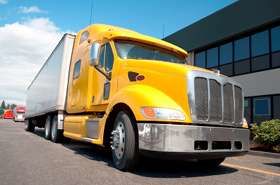DEER SEASON! Truck Drivers, Have You Hit One Yet?
Topic 1721 | Page 1

Tips for Driving in Deer Country Vehicles kill hundreds of deer each year in Washington. Deer will cross roads at any time of day or night, creating a hazard for the vehicles, passengers, and deer. More than half of all deer/vehicle collisions occur in October and November. The rut (mating season) and peak days for hunting may account for this.
Here are driving tips to help prevent collisions:
- Deer are most active at dawn and dusk. Be especially watchful during these times.
- One deer crossing the road may be a sign that more deer are about to cross. Watch for other deer— they will move fast to catch up with leaders, mothers, or mates and may not pay attention to traffic.
- When you see brake lights, it could be because the driver ahead of you has spotted a deer. Stay alert as you drive by the spot, as more deer could try to cross.
- Wonder why the person ahead is driving so slowly? The driver may know where to slow down and be extra alert for deer. Don’t be too quick to pass, and watch out.
- Take note of deer-crossing signs and drive accordingly. They were put there for a reason.
- Try to drive more slowly at night, giving yourself time to see a deer with your headlights. Lowering the brightness of your dashboard lights slightly will make it easier to see deer.
- Be especially watchful when traveling near steep roadside banks. Deer will pop onto the roadway with little or no warning.
- Be aware that headlights confuse deer and may cause them to move erratically or stop. Young animals in particular do not recognize that vehicles are a threat.
- Deer hooves slip on pavement and a deer may fall in front of your vehicle just when you think it is jumping away.
- Deer whistles, small devices that can be mounted on your vehicle, emit a shrill sound that supposedly alerts deer nearby. (Humans cannot hear the sound.) How well the devices work is not scientifically known.
If a collision with a deer seems imminent, take your foot off the accelerator and brake lightly. But—and this is critical—keep a firm hold on the steering wheel while keeping the vehicle straight. Do not swerve in an attempt to miss the deer. Insurance adjusters claim that more car damage and personal injury is caused when drivers attempt to avoid collision with a deer and instead collide with guardrails or roll down grades.
If you accidentally hit and kill a deer, try to move the animal off the road—providing you can do so in complete safety. Otherwise, report the location of the deer’s body to the city, county, or state highway department with jurisdiction for the road. If no action is taken, contact the local police department, and the agency will arrange for the body to be removed. This will prevent scavengers from being attracted onto the road, and eliminate a potential traffic hazard. If the deer is wounded, call the non-emergency number of the local police department and describe the animal’s location. Emphasize that the injured deer is a traffic hazard to help ensure that someone will com`e quickly.

Yes. Steven by most company standards it is a reportable accident. I live in Georgia as you can see and we have them running all over the place. The company I worked for years ago was out of Lithia Springs Ga. Because we ran back roads as well, we always had to be careful. Because of the damage a Deer or Moose can do, nit reporting it could land you in some big trouble.
I know that sometimes the damage is minimal. You may not call the authorities right away, but I would notify my dispatch. Let them be the one to make the call on contacting authority. What is good these days is that with cameras on cell phones you can take pictures that can be texted or emailed into dispatch in a matter of minutes. You want to always cover yourself in any situation.
The biggest issue here though is safety.
This thread was to put an awareness out there that many drivers may not be thinking of. We have so many things that we are doing on a daily basis that often times we forget. For truck driver that could be not only dangerous, but deadly.
Heavy C. has pointed out another good situation for those in the NE and driving in the snow laden areas. Snowmobiles. At this time of year too, many people are on those things. Just as he said, they think they can get across a highway with no problem. They are not thinking about all possibilities that can occur to stop them. Most are out having a good time and could care less. This again is where the drivers skills come into play. Thank you for pointing that out for us Heavy C.
HOS:
Hours Of Service
HOS refers to the logbook hours of service regulations.OOS:
When a violation by either a driver or company is confirmed, an out-of-service order removes either the driver or the vehicle from the roadway until the violation is corrected.

Here in SE Iowa ya gotta REALLY watch out for the deer, lately they've been hanging out on the roads during the day in groups of 5 or more, and it's more difficult IMO to spot them during the daytime because they blend so well with trees etc during the daytime. Of course they're still out at night... The rule of thumb about deer: "Where there is ONE deer, there are bound to be MANY deer".
Deer damage can cost a LOT more than people ever imagine.
My dad was hauling cattle (our own personal cattle, not commercial) to our new place some 6 years ago and a deer ran into the side of the truck, actually it bounced off of the front bumper then slammed into the side of the truck. 6yrs later I'm fixing the truck, spent over $1000 already on the front of the truck, that includes bumper, lights, etc. Fixing the side of the truck would run another grand or so. We never realized how much damage it really DID do until I started pulling it apart to fix stuff...
I can't really give much advice about handling deer on the road, other than watch for the eyes, and slow down when you see 'em. They're not so likely to be along busy highways, but that doesn't mean they aren't there.
I've lived out in the country the majority of my life and I agree - it's deer season - lookout!!!
Oh, and for those who aren't that familiar with em - they rarely travel alone. If you see a deer, you can almost be certain there are more within 100 feet or so.
HOS:
Hours Of Service
HOS refers to the logbook hours of service regulations.
Iowa and West Virginia are the TOP TWO states for deer to vehicle accidents. Also the deer in Iowa are "prehistoric from the land that time forgot, HUGE.
Dave
I have seen hit deer every day the last week or so. When I first started training, my very first night driving, I was driving south through Texas and saw a deer running in circles on the side of the road. "Don't do it!" I shouted to myself, but as I was passing he darted right into the side of the truck! Thunk! I didn't stop. Didn't know I was supposed to. When I told my trainer when he woke up he freaked out and ran out to look but there wasn't any visible damage.
I have seen LOTS of deer, but only been hit by 1. Usually they are just standing there... or, dead on the road because someone else already hit them.
Southern Colorado ...well most of Colorado has big mule deer as well as ELK now those will leave a mark a few moose but not usually near roadways. Twilight and just before dawn are when they are most active, I look outside marker posts for a pair of green dots myself not sure if I'm doing it right but its what I do. 160 from Walsenburg to Cortez the Elk are particularly active during the rut.
DOT:
Department Of Transportation
A department of the federal executive branch responsible for the national highways and for railroad and airline safety. It also manages Amtrak, the national railroad system, and the Coast Guard.
State and Federal DOT Officers are responsible for commercial vehicle enforcement. "The truck police" you could call them.
HOS:
Hours Of Service
HOS refers to the logbook hours of service regulations.OOS:
When a violation by either a driver or company is confirmed, an out-of-service order removes either the driver or the vehicle from the roadway until the violation is corrected.

Its a bit different driving a car at night compared to driving the truck, however i do pay attention to the sides of the road looking for those two green or amber glows from my headlights, indicating an animal.
HOS:
Hours Of Service
HOS refers to the logbook hours of service regulations.
So is hitting a deer (or animal) with your truck considered an accident? Does this go on your record? Sure, if you hit a rabbit, definitely no need to stop, IMHO. But if you hit an elk, those things are as big as Humvees as it is. They will do damage of some sort. How do you handle that? Full-blown call the police and get a report?
HOS:
Hours Of Service
HOS refers to the logbook hours of service regulations.Tis the season for all kinds of hazards. Not sure about the southern half of the country but, up here to northern NE it's not only deer season but it's Moose season as well. If you give me the choice i'd rather hit a deer. Worst of all though, up this way is when the snow breaks out and the sled runners come out of the woodwork. Snowmobilers at least up here are terrible. They cross main roads without even giving it a second glance. They think there quick enough to get through traffic without a worry. So you've always gotta keep a look out for any paths coming out of the woods.
OOS:
When a violation by either a driver or company is confirmed, an out-of-service order removes either the driver or the vehicle from the roadway until the violation is corrected.

Yes. Steven by most company standards it is a reportable accident. I live in Georgia as you can see and we have them running all over the place. The company I worked for years ago was out of Lithia Springs Ga. Because we ran back roads as well, we always had to be careful. Because of the damage a Deer or Moose can do, nit reporting it could land you in some big trouble.
I know that sometimes the damage is minimal. You may not call the authorities right away, but I would notify my dispatch. Let them be the one to make the call on contacting authority. What is good these days is that with cameras on cell phones you can take pictures that can be texted or emailed into dispatch in a matter of minutes. You want to always cover yourself in any situation.
The biggest issue here though is safety.
This thread was to put an awareness out there that many drivers may not be thinking of. We have so many things that we are doing on a daily basis that often times we forget. For truck driver that could be not only dangerous, but deadly.
Heavy C. has pointed out another good situation for those in the NE and driving in the snow laden areas. Snowmobiles. At this time of year too, many people are on those things. Just as he said, they think they can get across a highway with no problem. They are not thinking about all possibilities that can occur to stop them. Most are out having a good time and could care less. This again is where the drivers skills come into play. Thank you for pointing that out for us Heavy C.
HOS:
Hours Of Service
HOS refers to the logbook hours of service regulations.OOS:
When a violation by either a driver or company is confirmed, an out-of-service order removes either the driver or the vehicle from the roadway until the violation is corrected.

My brother drives Doubles for Fed Ex and was just telling me yesterday he made Bambi jelly on I-84 in NY monday night. No damage to the truck and his DM was just happy he didn't try to swerve.
Doubles:
Refers to pulling two trailers at the same time, otherwise known as "pups" or "pup trailers" because they're only about 28 feet long. However there are some states that allow doubles that are each 48 feet in length.
Dm:
Dispatcher, Fleet Manager, Driver Manager
The primary person a driver communicates with at his/her company. A dispatcher can play many roles, depending on the company's structure. Dispatchers may assign freight, file requests for home time, relay messages between the driver and management, inform customer service of any delays, change appointment times, and report information to the load planners.New Reply:
New! Check out our help videos for a better understanding of our forum features

















Preview:
This topic has the following tags:
Advice For New Truck Drivers Driver Responsibilities Safe Driving Tips Truck Driver Safety Trucking Accidents







 TT On Facebook
TT On Facebook
Just a quick advisory for those who are not thinking about them. I know some people don't think they will ever hit one, but just as you think it, it happens.
They are everywhere and they can get you before you know it. I have seen many of drivers at truck stops over the years who looked like they had just been hit by a freight train. I have also heard drivers say things like, "Do you see how big my truck is..or he ain't gotta chance...or better yet I am just as big as a train". Nope, not a good thing to be thinking.
The best one is, " I travel mostly city highways". Have you seen the reports of bears and coyotes lately on the news? They were in the city. What makes a person think a Deer won't travel to the city highways? Do they tell each other not to go to the city?
Wait until you see one hit by a truck driver doing about 70 mph and it flips up over the hood and into the next lane of traffic where that 4 wheeler is traveling. Not a pretty site.
Just want to get all of you thinking.
Question: What time of day or night will you see a DEER more often? And what area in reference to the road will you see him?
HOS:
Hours Of Service
HOS refers to the logbook hours of service regulations.